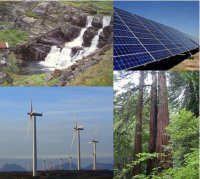Utility scale renewables: The new normal?
If utilities aren't thinking seriously about renewable energy, they'd better start. Renewable energy is quickly moving from an initiative of progressive "green" utilities to an industry imperative. And it brings with it serious challenges -- and benefits -- for utilities and consumers alike.
 |
|
Last year, about 13 percent of U.S. electricity was generated from renewable sources. |
The changing renewables marketplace
Last year, about 13 percent of U.S. electricity was generated from renewable sources. Global wind generation is taking off, while hydro and geothermal remain in steady development. Solar PV installations were up nearly 43 percent in 2011 with a compound annual growth rate of 60 percent over the past five years. This includes an estimated 10 GW gap between commercial solar capacity and installations, according to Lisa Frantzis, managing director at Navigant Consulting, who spoke at RETECH recently in D.C. Overall, costs for PV modules have dropped 75 percent since 2008.
It might not seem like much in the grand scheme of things, but it is significant especially given the multitude of obstacles associated with generating renewable energy, which include issues of regulation, grid integration and pricing. These challenges are only exaggerated as utilities begin to beef up renewable energy portfolios on a large scale -- whether because of mandated renewable portfolio standards, customer demand or environmental standards.
| ______________________________ With storage technologies still struggling to reach attractive (or even realistic) price points, utilities need to find smarter ways to balance power generation and make sure it is reliable enough to meet loads. ______________________________ |
This migration toward utility-scale renewables may be indicative of a larger change in the way the U.S. consumes energy and not simply an effect of declining prices.
"What's really going on here is shifts in how energy is being consumed in the U.S. and improvements in use and efficiency," said Adam Sieminski, administrator of the U.S. Energy Information Association (EIA), highlighting the expected longevity of the renewable energy "boom," at the recent RETECH conference.
He added that this change is fueled by a projected decrease in energy demand over the next quarter century driven by efficiency improvements as well as gas prices that could eclipse $5 or $6 a gallon.
Grappling with variable generation
As the percentage of electricity generation coming from renewables continues to rise, so does the importance of managing these different sources. Intermittency of renewables is a very real concern for utilities. With storage technologies still struggling to reach attractive (or even realistic) price points, utilities need to find smarter ways to balance power generation and make sure it is reliable enough to meet loads.
One option is to think more strongly about where to site renewable generation to optimize transmission and distribution.
"When renewables only had a small percentage in the penetration marketplace, it was not an issue. Now it's becoming more of an issue and utilities are beginning to think of how they can more strategically locate these renewable assets," Frantzis said.
Natural gas, with rock-bottom prices, could also be a viable and convenient solution to bridging gaps in and overcoming the uncertainty of renewable generation.
Encouraging sustained growth
| ______________________________ This migration toward utility-scale renewables may be indicative of a larger change in the way the U.S. consumes energy. ______________________________ |
Utility-scale renewable energy is poised for continued growth, due to RPS standards and the understood need across the industry that traditional generation sources are not sustainable. Eliminating the ability to "store," RPS standards could be one way to ensure continued growth of the renewable energy sector, as generating utilities would be forced to have more renewable power on hand, ready to be deployed, said Mark Taylor, a senior associate for Bloomberg New Energy Finance, speaking at RETECH.
"Right now, utilities are full because they can just produce, produce, produce, and then just store those RECs [renewable energy credits] in real time. That would mean they would have to have more capacity at the ready," Taylor said.
The bottom line is that the continued overall development of the smart grid is positioned to be utilities biggest asset to easing the deployment of utility-scale renewable generation.
"When the smart grid gets fully implemented, it can actually help in terms of the amount of intermittent renewables -- especially photovoltaics -- that are on the grid and it allows you to deal with some of the ancillary services and provide a little bit higher capacity," Frantzis said.